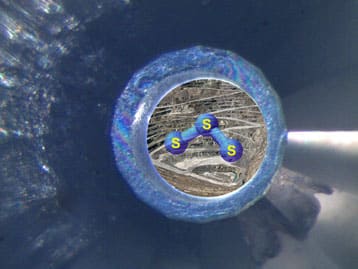A new form of sulfur found in geological fluids - the ion symbolized as S3-. The discovery could provide ways to locate new deposits of precious metals, such as gold and copper

Sulfur is the sixth most abundant element on Earth and plays an important role in many biological and geological processes. A joint team of researchers from Germany and France identified, based on laboratory measurements, a new form of sulfur found in geological fluids - the ion symbolized as S3-. The discovery could provide ways to locate new deposits of precious metals, such as gold and copper. The findings were published in the prestigious journal Science.
Until today, geochemists believed that only two forms of sulfur-containing compounds exist inside the earth: sulfides (based on H2S or S2-) and sulfates (based on H2SO4 or SO42-). Until today, there was no way to insert a detector directly into the hydrothermal fluids (a natural, hot watery fluid whose temperature is usually over one hundred degrees Celsius) flowing between the rocks in order to verify this theory.
In order to overcome this problem and test their hypothesis, the researchers first created liquids similar to those found in the earth's crust and mantle, that is, solutions containing elemental sulfur (S) and thiosulfates (molecules containing the ions S2O32−). In the next step, they used a diamond anvil cell in order to bring the liquids to temperatures and pressures such as are found at depths of several kilometers in the thick of the earth (several hundreds of degrees and tens of thousands of atmospheres).
The researchers used an optical method known as Raman spectroscopy to identify the chemical forms, and they were surprised to discover not only two forms of sulfur, but three, with the third being the trisulfide ion S3-. The finding was a double surprise: although this form was already known to chemists (it is found in sulfur-containing silicate glass and in dark blue pigments, for example), it has never been observed in aqueous solutions.
Finding this ion during these experiments means that sulfur must be much more mobile in hydrothermal fluids in the Earth's crust than what researchers previously thought. This is due to the reason that unlike sulfides and sulfates, which bind to minerals as soon as they appear in liquids, it has been proven that the S3- ion is particularly stable in an aqueous environment. In other words, below the surface of the ground these ions must travel long distances in their dissolved form, pulling with them the metals to which they were bound. Therefore, it is possible that this chemical crust is the main transport material for metals in two main deposits of gold and copper: Archaean greenstone belts and subduction zone magmas.
The discovery could provide additional signs in favor of search methods for new deposits by helping geologists locate the routes through which the metals move before the formation of ore strips between the rock layers.
In addition, the presence of the S3- ion in hydrothermal fluids may affect the distribution models of the sulfur isotope, which until now have not considered these chemical forms. These findings could, for example, help scientists gain more insights regarding the geological conditions that prevailed in the Earth's crust and on its surface for a short period after the appearance of life.

One response
I wanted to correct some inaccuracies as written in the body of the article, this ion is not new, it has been known for many years, and it is what gives the blue color to the lapis lazuli gemstone. The innovation in the article is the geochemical role of this formation.
Apart from this, geochemists are familiar with many more forms of sulfur in geological environments besides sulfides and sulfates (eg polysulfides, sulfites, thiosulfates).